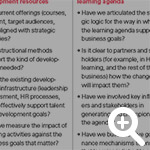Aligning Corporate Learning With Strategy
Too many corporate learning and development programs focus on the wrong things. A better approach to developing a company’s leadership and talent pipeline involves designing learning programs that link to the organization’s strategic priorities.
Survey after survey of CEOs points to a shortage of leadership and management talent as a leading concern.1 In an era when the capabilities of knowledge workers, not technology or capital, is often the key constraint on growth (particularly in emerging markets), this is hardly a surprise. The mystery is how ineffectual the response has been. It’s not that companies aren’t willing to invest in developing their people. They spend heavily in this area: In 2012, companies in developed economies spent nearly $400 billion on training.2 And yet, at least one study concludes that the majority of managers believe that employee performance wouldn’t suffer if their own company’s learning function were eliminated altogether!3 As corporate learning professionals, we find this lack of appreciation dismaying.
The fact is that much of the investment and effort that organizations spend on learning is focused on the wrong things. For example, companies often ask us to assess whether the types of learning experiences they provide their employees are “cutting-edge.” The proliferation of online courses and just-in-time knowledge available through mobile apps is prompting organizations to rethink traditional approaches to learning, so it’s understandable that many corporate learning leaders are paying more attention to innovative modes of instruction. In our view, technology has the potential to expand and democratize the reach of learning in organizations. Moreover, research in neuroscience and the science of learning is revealing more every day about how effective learning experiences engage the cognitive and emotional centers of our brains. But breakthrough advances will only be possible when learning is linked to business goals. In our opinion, the emphasis should be on strategic alignment of learning rather than on how learning is delivered.
The importance of alignment in learning and development is receiving increasing attention.4 In 2009, the European Foundation for Management Development (EFMD), based in Ixelles, Belgium, established a system for accrediting corporate learning organizations that included a set of criteria for assessing how well corporate learning aligns with overall corporate strategy. EFMD’s Corporate Learning Improvement Process, which one of us helped develop, was the first effort of its kind to define research-based assessment standards for evaluating and accrediting corporate universities and learning functions. One notable finding in the accreditation reviews was the relatively weak performance on measures of learning alignment and wide disparities among organizations on this dimension.5 This article builds on the research in this area to identify underlying causes of poor learning alignment and best practices of leading companies.
The word learning, which has largely replaced training in the corporate lexicon, suggests “knowledge for its own sake.” However, to justify its existence, corporate learning needs to serve the organization’s stated goals and should be based on what works. We see many corporate universities turning toward the academic paradigm, choosing to become gateways to the array of learning resources available from edX, Coursera, TED, Khan Academy, and social networking sites. Many companies assign much of the responsibility for deciding what, when, and how they learn to employees. But in our view, this approach won’t address the talent conundrum: There’s too much focus on learning and not enough on meaningful development.
If corporate learning and development is to remain relevant, learning leaders must shoulder the burden of developing the company’s talent capabilities and supporting strategic priorities. CEOs and top executives also have a critical role. Although many corporate initiatives might benefit from personal attention from the top, developing the company’s leadership talent must be on the list. The good news is that many top leaders seem interested in making this happen: In one survey of global CEOs, respondents said developing the leadership and talent pipeline was where they wanted to spend more of their personal time.6 Personal engagement and leadership on the part of the CEO can make a huge difference in setting the right tone for the organization.
For their part, some corporate learning executives are also rising to the challenge. They are beginning to take a more strategic view of their businesses and a proactive stance on the role of learning and development in delivering value — matching what we call the corporate “learning agenda” with the demands of talent development and business goals. We will describe some of these learning executives’ practices, which can serve as a model for implementing a corporate learning strategy. (See “About the Research.”)
Mapping the CEO Agenda
When two of us worked as management consultants, we typically began engagements with new clients by developing a profile of what we call the “CEO agenda.” Culled from analyst reports, corporate websites, and personal interviews, the CEO agenda allowed us to identify the mission-critical concerns of the company’s top leadership and tailor discussions to that agenda. Effective learning leaders take a similar approach, developing a learning agenda for their organizations that is reflective of the CEO’s priorities. Mapping the CEO’s agenda is the first step in aligning learning with strategy. (See “Guiding Questions for Learning Executives.”)
Guiding Questions for Learning Executives
Learning leaders can ask critical questions at each stage of the process to guide the creation of a corporate learning strategy.
Consider the example of Paddy Coyne, vice president of enterprise learning, leadership development, and global talent at Royal Dutch Shell plc. After starting his career at Shell as a project engineer, Coyne then spent 14 years with the management consulting firm McKinsey & Company Inc. before returning to Shell in 2007. When Shell’s previous CEO Peter Voser was appointed CEO in 2009, the company announced plans to concentrate on global business lines that would enable it to be “the world’s most competitive and innovative energy company.”7 Coyne saw an opportunity to rethink the way the company developed its leaders in accordance with Voser’s vision.
Following extensive internal and external conversations on the changing nature of Shell’s context and leadership needs, a project team reporting to the CEO and head of HR identified four leadership attributes they saw as critical for future leaders, essentially replacing the leadership model that had been in place for more than a decade. This meant changing Shell’s approach to developing leaders, placing “in-role” development through on-the-job experiences at the heart of a new leadership development system.
The guiding principle (commonly expressed as “Shell leaders personally develop the best people”8) emphasized line manager responsibility for cultivating desired behaviors. This required learning and HR professionals to adopt new ways of working and to revamp the leadership development portfolio to focus on key leadership transition points. To ensure that learning continued to support the needs of the business, Coyne formed advisory panels of business leaders to guide the development of new programs.
Although Shell’s effort is still ongoing, it’s an example of corporate learning that links professional development directly to business goals.9 Starting with the CEO agenda helps cut through the noise of multiple initiatives vying for attention to reveal the few, critical, “must-win battles” that the CEO is committed to achieve.
How does this approach differ from the starting point of most learning and development programs? Typically, the first step in a new learning initiative is a training needs assessment, which uses surveys and in-depth interviews with business leaders to understand the skills gaps and “pain points” they want training to address. For example, a global consumer goods company we’ve worked with conducted such an assessment for a new leadership development program aimed at midlevel leaders across a number of its operating divisions. The company engaged a team of instructional design consultants to survey dozens of managers, asking them to rank the top development needs of leaders in multiple categories. The collected and tabulated responses demonstrated a desire for additional training in areas including coaching for performance, inspirational leadership, and communications. The course that emerged was a diverse smorgasbord of skills training. Although all of the skills selected were valuable, as a group they did not reflect anything specific about the organization or its strategy. Indeed, the conclusions of these types of training needs assessments tend to be similar across organizations. Given that midlevel managers at many large corporations face some of the same challenges, this is not surprising. What is missing from the picture, however, is a connection to the unique circumstances of the business and the priorities critical to its success.
No matter how talented the instructors or how dedicated the learners, these kinds of learning interventions based on needs assessments are unlikely to move the needle on the business priorities that matter most. Furthermore, by outsourcing the process, the company’s learning leaders missed an opportunity to get “close to the business” in a meaningful way. In some cases, consultants who also provide instructional design and training delivery to the same clients may have vested interests in the outcomes of a needs assessment and can skew the analysis. As discussed above, a better approach is to start from the business agenda to ensure that training supports the capabilities required by the company’s strategy.
Mapping the CEO agenda as a starting point for the learning strategy is powerful because it provides focus for training activities that allow learning leaders to link development initiatives to specific business goals. Yet this approach remains more the exception than the rule. One reason for this may be that declared business priorities (for example, “growth”) are sometimes ambiguous. Learning leaders need to unpack the CEO agenda to identify the key drivers — for example, “doubling sales of new products in emerging markets” — to which learning resources can be directed. Companies that are able to align the mission, focus, processes, and capabilities of their learning assets with tangible business goals truly have a corporate learning strategy.
In many companies, the governance structures for learning and development can dilute the immediacy of the contact with the rest of the business. One study found that less than a third of companies have chief learning officers reporting directly to the CEO or company board.10 More often, learning reports to the head of HR or other functional leaders. This is no reason, however, for learning executives to be disconnected from the strategic agenda. Rather, they need to be proactive in discussing and working with this agenda. Interactions between learning functions and executives in other parts of the business are too often squandered in administrative debates over allocation of training costs and learning hours delivered. Chief learning officers need to take a more strategic approach, and the company’s senior executives must ensure that capability-building efforts are directed at the things that matter most to the company.
Mapping the CEO agenda and its implications for corporate learning is thus the first step in constructing the company’s learning agenda. The next is to operationalize the learning agenda through the portfolio of learning and development activities.
Aligning Learning and Development Resources
After mapping the CEO agenda, it’s important to take an inventory of existing learning and development resources: Companies need to do this on a regular basis to ensure that the activities in place reflect the company’s learning strategy. In our experience, however, conducting such a “learning inventory” is often overlooked.
A few years ago, one of us reviewed the global learning programs for a large, decentralized multinational and was alarmed to find that the majority of spending on learning activities could not be properly accounted for due to lax budgeting procedures among dozens of scattered learning teams working with hundreds of external vendors. Although this situation was extreme (it amounted to tens of millions of dollars), it is not atypical of some large organizations. Just getting a handle on the learning portfolio already deployed can be a challenge.
In addition to doing an inventory of the current training portfolio, the assessment should include a review of the company’s development infrastructure. For example, when Shell decided to transform its approach to leadership development, it had a fairly traditional talent management process in which line managers largely outsourced responsibility for talent development to HR professionals. The new process amounted to a paradigm shift, involving an integrated approach to in-role development, key talent processes, and learning programs. These efforts were designed to help accelerate the development of employees through carefully orchestrated on-the-job learning experiences while making business leaders responsible for building the strength of talent pipelines. The move therefore required a complete rethinking of the development ecosystem, including promotion and succession planning processes and the supporting role played by HR and learning professionals.
Companies should, however, be cautious about making wholesale changes to learning portfolios and organizational structures. Occasionally, such changes are warranted in light of shifts in the company’s mission or business context. Yet radical changes in training curricula can cause major disruptions. Although Shell chose to retire its entire learning portfolio, in part to signal a clear break with the past, this entailed a six-month pause in the delivery of leadership training worldwide as the company reset the focus and emphasis of learning programs. General Electric Co., by contrast, took a more gradual approach. In 2010, GE began to phase in substantial changes to the direction and content of its executive leadership programs for its most senior leaders, while also maintaining many of the deeply rooted structures and features it had used over the years.11
Time and again, we’ve seen new chief learning officers dump existing programs for reasons of turf or temperament rather than strategy. That’s a mistake. As long as the company’s strategy does not change, the link between the corporate learning agenda and the CEO agenda should be relatively stable over time. Reorganizations tend to occur all too frequently in corporate learning departments, but they should be limited to situations where they are warranted — for example, when the learning agenda is misaligned with corporate strategy or the strategy changes.
Some corporate learning organizations adopt explicit mission statements linked to business objectives as a way of embedding the priorities of the CEO agenda into their guiding principles. As the company’s strategy evolves, the learning mission needs to do so as well. Capgemini, a global provider of IT services and consulting headquartered in Paris, founded its corporate university during a period of rapid growth through mergers and acquisitions. The corporate university launched with a mission of being the “heart, home, and hub” of the group — the place where leaders from diverse, decentralized businesses physically came together, developed personal bonds, and built a connection to the company. In 1998, the company purchased a property near its Paris headquarters to serve as the physical location and symbol of the university. In keeping with its mission of cultural integration, the majority of university learning programs were delivered on the campus through 2007.
However, as Capgemini moved into a new phase of growth, the role of its corporate university changed accordingly. Between 2007 and 2012, the university became the driver of global content, ensuring that common methodologies and ways of working were rolled out in a consistent way to the disparate business units. It also organized worldwide learning events centered on business priorities with global implications. To reflect the new reality, the university’s mission statement was revised to reflect its new role. By 2012, the emphasis shifted to virtual and local delivery of programs; less than 3% of university learning took place at the central campus.
Responding to customers’ demands for more integrated IT solutions, Capgemini shifted its strategy once more. In 2013, it reframed the mission of the university to ensure that learning initiatives supported the CEO’s push to break down silos and build linkages between business units. In a sense, this represented a return to the founding mission of the university as a “hub” for exchange and relationship building. Accordingly, the central campus again took on a more prominent role as a learning forum and meeting place for company executives.
Gaining Buy-In for the Learning Agenda
As with the CEO agenda, the learning agenda should articulate the essential strategic initiatives for corporate learning. However, choices about what to keep, eliminate, or add to bring learning activities in line with business priorities should not be made in isolation. To enact change, it’s important to get input and buy-in from both the learning organization and leaders in the rest of the business — all the way to the CEO level. Creating the right supporting structures and interfaces with the business units, HR, and other related functions is critical.
When Eivind Slaaen, senior vice president of human resources at Hilti AG wanted to take the company’s approach to leadership development in a new direction, he recognized the need to engage line managers. Slaaen’s vision for learning at Hilti, a Liechtenstein-based producer of high-end power tools for the construction industry, emphasized development of new managers through on-the-job experiences supported by a multiyear process of formal learning interventions. “We’ve stopped treating learning as stand-alone and see this more as a journey,” says Slaaen. “Rather than thinking you can teach people what they’re supposed to know in a couple weeks of training, we’re pulling the line [management] in as a partner — so you need to convince others to be a part of that journey.”
It’s difficult to overstate the significance of CEO involvement in driving support for corporate learning programs — particularly leadership development and senior management training. (GE’s CEO has famously participated directly in every executive leadership program for more than 30 years — with one exception, when then-CEO Jack Welch underwent heart bypass surgery).12 Having exposure to the priorities of top management is key to establishing the credibility and relevance of learning initiatives. In the case of Shell, the CEO actively sponsored the new approach to leadership development and was instrumental in communicating its importance and meaning through personal storytelling that reinforced the link between leadership behaviors and business results.
At Unilever, CEO Paul Polman has made leadership development a key pillar of his long-term vision. He charged the vice president of global learning and capability development with designing a senior leadership development program that was more external-looking and focused on long-term performance. Executives received invitations to the program from Polman himself, who personally participates in the program. The company signaled its commitment to executive development with the construction of a new learning center in Singapore, the first major expansion of its corporate learning infrastructure in nearly 60 years.13
Although the personal involvement of the CEO in learning initiatives can have a decisive impact, a broader effort of stakeholder management is typically required to promote and gain buy-in for the learning agenda. Learning leaders should map out a concerted “campaign” to inform and gather input from key influencers and decision makers in other parts of the business. For example, our work with one organization revealed that funding models based on participant fees charged to business units was a hindrance to developing a strategic approach to corporate learning. In this case, getting the backing of the CFO was critical to developing more effective financing structures for learning initiatives. A disciplined effort of stakeholder engagement and outreach gives learning executives an opportunity to deepen their understanding of strategic priorities and demonstrate the business value of learning interventions.
Another vehicle for advancing the learning agenda and ensuring that it remains responsive to the needs of the business is creating governance mechanisms such as learning advisory boards. Shell created advisory panels composed of executives representing all of its businesses to help set priorities, advise on the development of new curriculum, and provide periodic reviews of the impact of the programs. Capgemini University invited leaders from the various business units to help steer the curriculum in their areas and designated senior members of the learning team to act as liaisons between the business and the university. These governance structures help ensure that local learning activities remain aligned with the global learning agenda while also helping corporate learning leaders adapt to the changing needs of different parts of the business.
Activating the Learning Agenda
Once the learning agenda is in place, it needs to be activated through programmatic activities and changes to the learning portfolio. As with any change of this nature, corporate leaders should be prepared to face stiff resistance from entrenched forces that want to maintain the status quo. An inclusive approach to stakeholder engagement in early stages of the process will lessen opposition and facilitate implementation.
Nevertheless, there can be difficult choices. In many organizations we’ve worked with, there are good programs that are well regarded and popular with participants but not aligned with the revised learning agenda. Programs and learning initiatives that do not advance the ball toward business goals should be eliminated or brought into line with business needs. Sometimes this requires bringing in different learning personnel with the relevant expertise and instructional design skills to meet the new objectives. The company’s learning agenda should be the “North Star” for all corporate learning and development — the set of orienting principles against which program design choices are tested.
Activating the learning agenda also requires that the goals of the corporate learning strategy be applied at the functional, regional, and business-unit levels. Just as business units need to align priorities and investment with the top-level strategy, learning leaders need to ensure that training and learning interventions are tailored to the specific needs of the business they serve and are aligned with the company’s global learning agenda.
A Key Strategic Question
The approach we have presented is a practical way of addressing the key strategic question for corporate learning: “Are we doing enough of the right things to develop the capabilities our people need to deliver the outcomes that matter most to the business?” Companies that answer this question in the affirmative can activate a powerful lever of competitive advantage.
The close interconnection of development activities with business priorities is the hallmark of an effective corporate learning strategy. It requires much more than just getting senior leaders to turn up at leadership training events. Rather, it means viewing the corporate learning agenda as an essential extension of the CEO agenda as it applies to the company’s human capital.
References (13)
1. According to a 2012 survey, one in four CEOs said they were unable to pursue a market opportunity or have had to cancel or delay a strategic initiative because of talent constraints. Further, a 2011 World Economic Forum report describes the talent conundrum in stark terms: “Soon staggering talent gaps will appear in large parts of the world threatening economic growth. Economies will struggle to remain competitive while organizations will compete for talent on an unprecedented scale. Now, human capital is replacing financial capital as the engine of economic prosperity.” See, respectively, “15th Annual Global CEO Survey 2012: Delivering Results — Growth and Value in a Volatile World,” www.pwc.com; and World Economic Forum and Boston Consulting Group, “Global Talent Risk: Seven Responses,” 2011, www.weforum.org.
2. P. Kolo, R. Strack, P. Cavat, R. Torres, and V. Bhalla, “Corporate Universities: An Engine for Human Capital,” July 18, 2013, www.bcgperspectives.com.


 View Exhibit
View Exhibit




Comments (2)
Travis Barker, MPA GCPM
Iskandar Noor